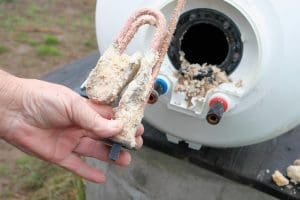See Part 1: Iron Levels in Southern Maryland Water
Effects of Iron in Water
 Iron in water can destroy plumbing and appliances, leading to significant water quality problems. Over time, high iron content accumulates, obstructing pipes, decreasing water pressure, and causing costly damage. Water heaters and washing machines experience diminished effectiveness, frequently forcing early replacement due to iron particulates.
Iron in water can destroy plumbing and appliances, leading to significant water quality problems. Over time, high iron content accumulates, obstructing pipes, decreasing water pressure, and causing costly damage. Water heaters and washing machines experience diminished effectiveness, frequently forcing early replacement due to iron particulates.
The presence of iron also leads to aesthetic issues. Discoloration and staining are widespread, with our sinks, tubs, and laundry frequently stained orange. These unsightly stains result from iron-oxidizing and precipitating out, making it essential to consider proper iron water filtration. Clothes washed in iron-infused water can suffer from ugly stains that are difficult to remove.
The impacts of impaired water quality go far beyond aesthetics. Water that is rich in iron can have a metallic taste, often compared to that of rusty nails. This metallic, bad-tasting water is unpalatable and taints food and drinks made with it, highlighting the need for effective water treatment systems.
Health risks, while rarer, merit attention. Iron is an essential nutrient for all of us. Ingesting excess amounts can result in grave diseases, including hemochromatosis, particularly when in conjunction with other heavy metals such as copper and lead. These substances leached by corrosive “hungry water” can lead to chronic but severe health issues.
Impact on Water Quality
Iron contamination is detrimental to water quality and safety. It impacts normal usage, rendering water unappealing and possibly hazardous. These issues must be addressed sooner rather than later. Testing your water directly from your drink source will give you the most accurate measurements of its iron level.
Orange Water Stains
Orange discoloration in laundry, plumbing fixtures, and other household items is often due to deposited iron. These stains commonly appear in sinks, tubs, and laundry.
Proper cleaning means using specialized iron stain removers. With regular maintenance and the right filtration system, you can prevent these stains from coming back, creating a cleaner home environment.
Testing and Removing Iron from Water
1. Identify Reliable Service Provider
When choosing a water testing and treatment service, consider these criteria:
- Check the manufacturer’s certifications and licenses to ensure they align with industry standards.
- Consider hiring companies with decades of expertise in tested water treatment solutions.
- Review customer reviews and testimonials to understand the company’s satisfaction rate and reliability.
2. Steps for Water Testing
 Preparing for water testing involves addressing water quality problems, such as high iron content and contaminants in your home water supply.
Preparing for water testing involves addressing water quality problems, such as high iron content and contaminants in your home water supply.
- Collect Samples: Use clean containers to avoid contamination.
- Follow all instructions included with the test kit or service.
- Conduct tests depending on source and usage. For Maryland residents, regular testing is smart because Maryland soils have high levels of iron.
3. Create Remediation Strategy
An effective strategy includes:
- Assessment: Thorough water quality tests are necessary before recommendations.
- Look into alternative treatment options, such as UV disinfecting lights or cartridge filters.
- Know how to deal with different kinds of iron, like ferrous iron, with appropriate treatments.
4. Install Treatment Solution
Consider these water quality problems when installing a water treatment system.
- Professional Installation: This ensures proper setup and longevity.
- DIY: May save costs but risks errors.
- Maintenance: Regular checks keep systems effective and prevent issues.
Conclusion
 Iron in water in Southern Maryland is an annoying problem many people face, but it doesn’t need to be a headache. Knowing the different types of iron and how they impact your water will put you in a better position to take the appropriate action. Regular testing is the only way to know what’s contaminating your water and how to treat it. Making the proper removal method clear will help you get safe, clean water for your home. It’s more than getting the iron out; it’s about enriching your daily experience. Having clean water will ensure a healthier home environment and peace of mind. Find solutions that make the most sense and improve your water quality.
Iron in water in Southern Maryland is an annoying problem many people face, but it doesn’t need to be a headache. Knowing the different types of iron and how they impact your water will put you in a better position to take the appropriate action. Regular testing is the only way to know what’s contaminating your water and how to treat it. Making the proper removal method clear will help you get safe, clean water for your home. It’s more than getting the iron out; it’s about enriching your daily experience. Having clean water will ensure a healthier home environment and peace of mind. Find solutions that make the most sense and improve your water quality.
Contact us and find out how you can enjoy iron-free water starting today.

Frequently Asked Questions
What are common types of iron found in Southern Maryland’s water?
Southern Maryland’s household water typically contains both ferric and ferrous iron. Ferric iron, being insoluble, leaves tell-tale orange stains, while ferrous iron is soluble and can produce metallic-tasting water. Both types can pose serious water quality problems.
How does iron affect water quality in Southern Maryland?
Iron in water is generally considered unsightly, as it can cause rusty orange stains on plumbing and fixtures. High iron content can give the water a metallic taste and smell, and excess iron can encourage bacteria growth like iron bacteria, leading to significant water quality problems.
Why is it important to test for iron in water?
Testing for iron can help determine the concentration and type of iron present, including high iron levels and particulates. This information is essential for choosing the right water treatment system to provide safe drinking water for your home.
What methods are effective for removing iron from water?
These water treatment systems, including oxidation filters and chemical treatments, effectively target high iron content, making your household water cleaner and clearer.
Can iron in water affect my health?
Generally, drinking water iron is not a health concern. While iron can add nutritional value in smaller concentrations, high iron levels can cause gastrointestinal discomfort and bothersome water quality problems, affecting the taste and appearance of food items and drinks.
How often should I test my water for iron levels?
In addition, it’s best to test your water at least once a year to ensure it is safe to drink. If you notice any changes in taste, color, or staining, it may indicate water quality problems that require more frequent testing.
Is professional help necessary for removing iron from water?
Indeed, it’s always a good idea to consult a water treatment professional. They can quickly determine the extent of the high iron content problem and recommend the most efficient treatment system customized to your unique situation.


0 Comments